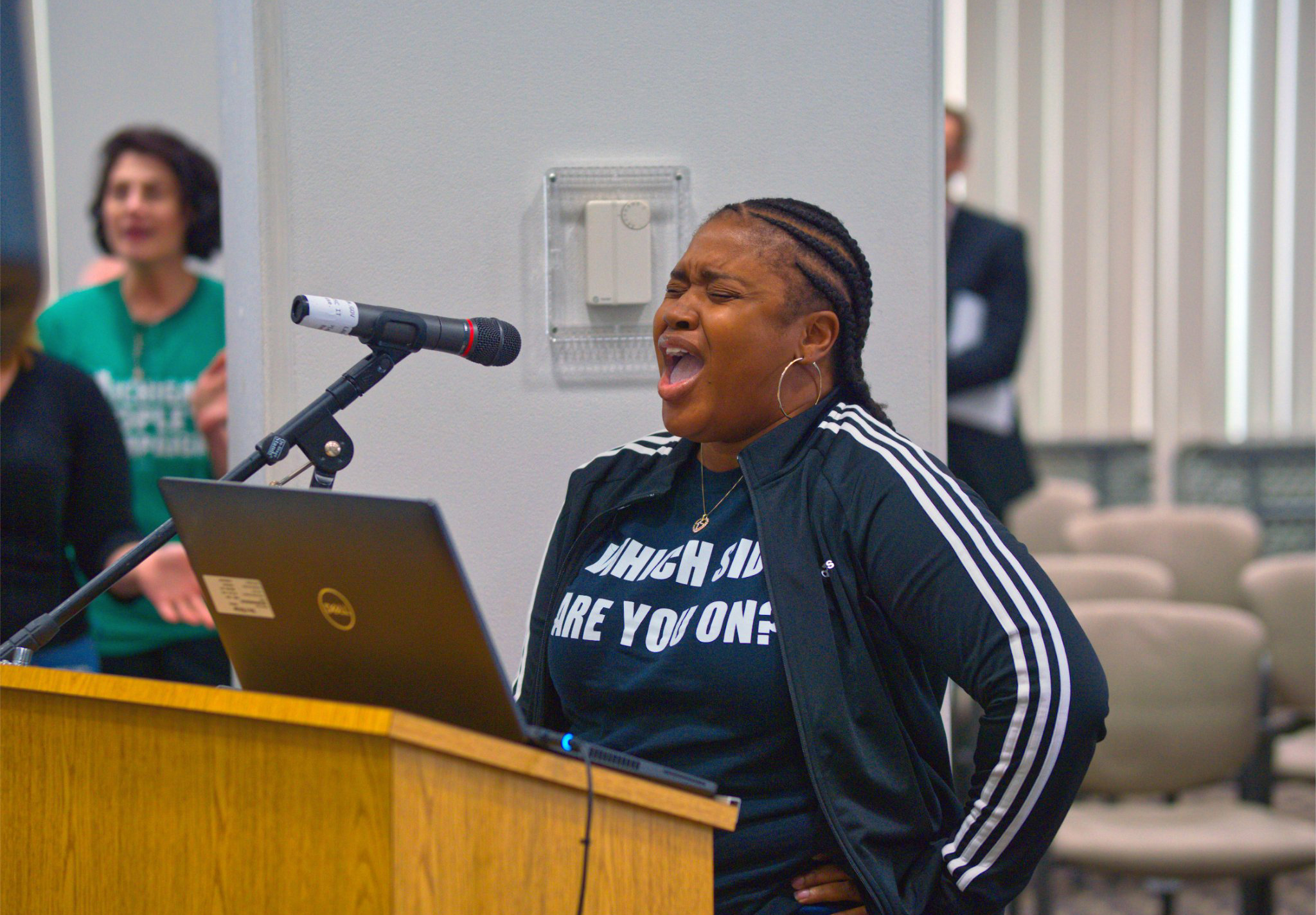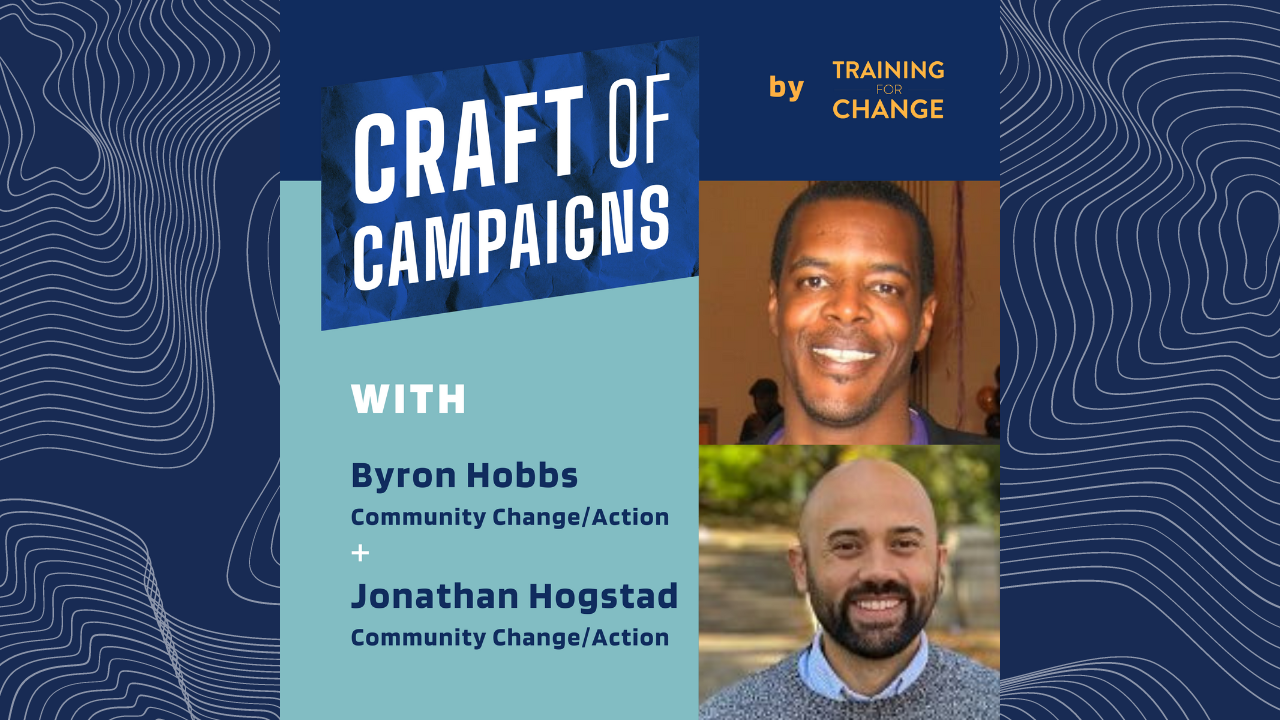
“In late July of 2022, fifty members of the Defend Black Voters Coalition – formed to stop right-wing voter suppression and election-denying efforts that had taken off since January 6th, 2021 – filed into a utility commission meeting in Detroit, Michigan. [They] waited patiently for other speakers to take their turns in an otherwise unremarkable meeting before gospel singer Corzetta Renee–from one of the constituent groups, MOSES Action–stepped forward to give public comment.” – Byron Hobbs and Jonathan Hogstad
At the microphone, she launched into a new rendition of “Which Side Are You On?,” with the crowd picking up the chorus:
Thank you for this hearing but it’s only a first step
You promised to serve the public but it’s a promise to be kept
Which side are you on, which side are you on?
How did Black-led basebuilding groups across Michigan come to target a utility company asking for permission to raise electricity rates in context of their campaign to force GOP legislators to stop supporting voter suppression? On the surface, it looks like these two things are completely disconnected, but there’s a lot we can learn from this campaign about how to cut an issue and identify our opponent’s weak points.
Too often, our campaigns seek to take political or corporate opponents head-on –– trying to shame or overwhelm them with the fury of our opposition –– at exactly the places they’re best prepared to defend against our attacks. This isn’t to say we should never try to disrupt their corporate headquarters or a key legislative hearing, but our protests alone are never sufficient to dislodge a tough opponent.
The Defend Black Voters campaign was formed as a response to the continued efforts of Michigan Republican lawmakers, even after January 6th, to overturn the 2020 election results. A number of statewide and local Black organizations were involved, supported by Community Change and a few other national groups. You’ll hear from these groups in the podcast episode attached to this write up, along with an update about how, in February 2024, the campaign evolved to focus on a new demand, building on leverage built during this first phase.
To understand how the organizations involved decided who to target with their many direct actions and mobilizations over 2021 and 2022, think about a triangle –– maybe one of those triangle magnets with which my five-year-old likes to build pretend princess castles. You can sit that triangle magnet upright on one of its sides. This is like the traditional view of power: it flows from a small point above us, in the hands of a few elite power-holders, down to the many of us below. But another way to look at it is that their power rests on our support, which we can withdraw at any time causing them to topple.
The upside-down triangle is a more accurate representation of how movements change the status quo, which is sometimes called the social view of power. A status quo is unstable; it rests on the support of specific constituencies. CEOs need the support of their shareholders, their board, their employees, often the financial industry press. Sometimes they deeply rely on the support of specific elected officials or other government ties. As I’m writing this, Starbucks executives have decided, after several years of a militantly anti-union status quo, that their support is getting shakier. They’ve been losing contracts on college campuses, their brand has been damaged probably to the tune of millions of dollars in negative publicity, and they would rather negotiate towards a more pro-union status quo than wait for a pillar of support to fall completely.
In Michigan, Defend Black Voters wanted to change the status quo, which was the ability of Republican state lawmakers to overturn elections after January 6th. Republicans sought to oppose the certification of election results while simultaneously making a larger effort to disenfranchise voters by passing a statewide referendum that would restrict voting rights. These lawmakers were the primary target: the ones who could give in to the campaign’s ultimate demand, which was to stop efforts to overturn elections and silence Black voters. The campaigners knew they didn’t have any leverage with the lawmakers themselves so they looked at their individual pillars of support, also called secondary targets. And making a list of these legislators’ largest campaign donors, six stood out as being especially vulnerable to the coalition’s strength around mobilizing pissed-off voters in key urban areas.
The first two were DTE and Consumers Energy, utility companies regulated by a three-member commission appointed by the Democratic governor. The utilities had to request permission to raise their rates –– a place they could be vulnerable. The public service commission became the tertiary target. The campaigners wanted the board to oppose a proposed rate hike, as a way of pressuring the utility companies into agreeing to no longer donate to candidates who advocated overturning elections.
The next two, BlueCross BlueShield and Delta Dental, are health insurers with billions of dollars in contracts to provide health coverage to local municipalities and public universities. Contracts overseen by local Democratic elected officials, and university trustees appointed by a Democratic governor. Those local elected officials and university trustees were the next set of tertiary targets, and they were asked to adopt responsible contractor policies that would ban localities from contracting with health insurers who provided political donations to election deniers.
Ford and GM, two of the state’s largest companies, were the final pair. One way to size up a target’s vulnerability is to look at their past behavior under pressure, and the campaigners had noticed that back in 2020, when GM was called out for not advertising with Black-owned media outlets, the company had quickly offered to negotiate. So the Defend Black Voters campaigners thought they might be similarly vulnerable to a public pressure campaign calling them out for indirectly supporting Black voter suppression. As you’ll hear in the podcast episode, this ended up being a weak assessment.
This story demonstrates, but doesn’t fully explain, how sophisticated campaigns often identify secondary targets. In our second episode this season, we heard about how a union used corporate research methods to identify the most important office building owners in a given downtown and then identified secondary targets like union pension funds and City Council corporate tax breaks. This campaign identified their six corporate targets using many of the same methods. And in this case, all six companies sponsored a right-wing policy conference in June 2022, which Defend Black Voters used to spotlight the Republicans enabling election denial efforts. All six also fit criteria the campaign borrowed from Community Change’s strategic campaigns model, which the organizers mention in our interview. This campaign also reflects how we often test out potential targets with our actions, looking for a reaction that would indicate weakness, and moving on if necessary, as this campaign ended up doing with Ford and GM.
But overall, Defend Black Voters’ assessment of their targets’ vulnerabilities was spot-on. In approaching decision-makers with leverage over BlueCross BlueShield, the coalition pointed out that the company had called on Republicans to stop election interference efforts in early 2021, but still went on to donate nearly $700,000 to party committees supporting election deniers. Democratic elected officials in the state’s largest county responded quickly after the organizers pointed out that taxpayer dollars, through contracts to BlueCross, were probably making their way to the campaign funds of candidates trying to suppress democracy. The Wayne County board passed a resolution calling on the companies to change their behavior just a few weeks after the direct actions at the policy conference mentioned earlier, in July 2022. By November, four other cities and counties passed their own resolutions.
The coalition had simultaneously taken aim at another secondary target, DTE, which had also contributed over $700,000 to an election denial effort called “Secure MI Vote.” Rather than protest DTE directly, the coalition targeted the state’s public utility commission, which is appointed by the governor. A direct action in June inside a commission meeting featuring a gospel singer had won them a first-of-its-kind public hearing on a proposed rate increase, which was held in August. Three months after that packed public hearing, featuring testimony from dozens of the coalition’s members, for the first time ever the commission denied 92% of the increase the company asked for, depriving DTE of a projected $388 million. You have to wonder if the company regretted that $770,000 in donations to vote-suppressors and election deniers.
In this interview, you’ll hear more about how organizers picked their targets and how they won on the rate increase issue. Even though Defend Black Voters put real pressure on the utilities by blocking the rate increase, those companies have not, as of a year later, agreed to stop financing right-wing lawmakers. This led to the newest phase of the fight, launched in February 2024, after we recorded this interview. The new campaign, called Taking Back Our Power Michigan, seeks to pass legislation to join other states like Georgia and Connecticut that ban corporations seeking government contracts and regulated industries like utilities from making political donations.
You can hear more about the considerations the half-dozen organizations used to diagnose targets, choose tactics, and build leverage in the full interview.
Byron Hobbs is a Senior Strategic Campaigner at Community Change/Action and an organizer with over 20 years of experience. Previously, he led organizational infrastructure and capacity-building work of Community Change’s Black-led partner organizations. He has also organized with SEIU and faith-based social justice groups in Chicago, where he is based.
Jonathan Hogstad is the Director of Strategic Campaigns & Research at Community Change/Action where his department builds strategic campaigning capacity in the grassroots movement through training and joint campaigning. He was previously Deputy Research Director at SEIU Local 32BJ and a capital strategies organizer at SEIU. He’s based in NYC.

